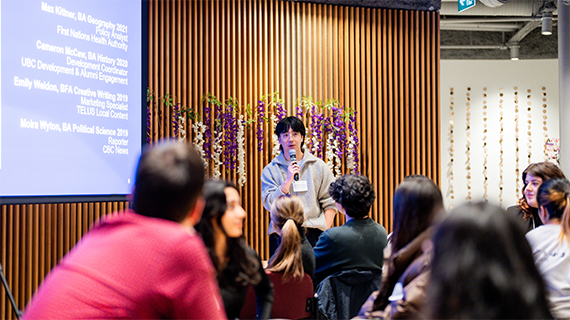Over two months have passed since President Trump issued his first travel order, temporarily barring people from seven Muslim-majority countries and all refugees from entering the United States.
After facing a legal and political backlash, the administration issued a revised order on March 6, dropping Iraq from the list of banned countries and clarifying the ban does not apply to existing visa or green card holders.
While the second ban has also been subject to legal challenges, critics are concerned that resistance is fading and that media are not paying as much attention. “My greatest concern is that we will all forget what we were so concerned about,” says Sara Shneiderman, an Assistant Professor of Anthropology. “Very quickly, racist, xenophobic, and anti-poor policies have been normalized at the legislative level, while hate crimes against a wide range of communities have increased.”
Associate Professor of Sociology Renisa Mawani says that while the ban has intensified Islamophobia, these developments are not new. She emphasizes the importance of studying historical precedents to the ban, not only to understand the role immigration history plays in current debates, but because histories of xenophobia “provide necessary inspiration for building solidarity and struggle against the forces of white nationalism.”
Shneiderman and Mawani were among several Faculty of Arts panelists who participated in a discussion around Trump’s ‘Muslim Ban’ last month, considering its historical parallels and how it would impact Muslims around the world. We asked four of the participants to share some reflections that emerged from their conversation, and explore how scholars and citizens can respond.


Iman Baobeid is a Yemeni MA student and artist at the Institute for Gender, Race, Sexuality and Social Justice.
Iman Baobeid, MA Student, Institute for Gender, Race, Sexuality and Social Justice
“The narrative of ‘national security’ has continually been used as a justification for racist and imperialist policies. Its utilization for the immigration ban and US military actions highlights the critical links that need to be made between Trump’s local and foreign policy decisions.”
While our focus has largely been US-centric, on issues such as the immigration and refugee ban, mass deportations, and anti-LGBTQ policies, the remnant effects of the Trump administration’s actions outside of the US are equally alarming. As a Yemeni scholar and citizen my attention falls directly on US operations and policies in my country. The January 29 raid in al-Bayda province that resulted in the deaths of 30 civilians marked an intensification of US involvement in Yemen. Trump is heir to US imperialist programs and policies propagated by the Obama administration and past presidencies. Given the history of the US, his actions are not especially novel. Yet, they do highlight a significant exacerbation, as seen by the uptick in airstrikes on Yemeni soil (30 airstrikes in 2 days in comparison to the 36 airstrikes conducted by the Obama administration in all of 2016).
In the context of the war in Yemen, the Trump administration will play a key role in defining the next decade, if not more, for the Yemeni population – and similarly for the Syrian, Iraqi, Libyan, Somali, and Sudanese people. Paired with the immigration ban, these policies have deep material ramifications, and it goes without saying that they build on existent xenophobic and racist attitudes that are institutionally enshrined. The narrative of “national security” has continually been used as a justification for racist and imperialist policies. Its utilization for the immigration ban and US military actions highlights the critical links that need to be made between Trump’s local and foreign policy decisions. Therefore, our resistance needs to locate the areas in which power is most threatened, and that is no easy task. That begins from our most intimate circles and expands outwards to support already existent social movements and communities fighting for social justice.


Chris Lee is Associate Professor of English, Director of the Asian Canadian and Asian Migration Studies Program (ACAM), and Acting Principal of St. John’s College. His research focuses on Asian diaspora literature and global Asian cultures.
Chris Lee, Associate Professor of English, Director of the Asian Canadian and Asian Migration Studies Program, Acting Principal of St. John’s College
“While Canada seems to be enjoying a moment of international acclaim at the moment in comparison to the US, it is crucial to remember that this country has its own entrenched histories of racism and exclusion going back to its founding, like the US, as a settler colony. Consequently, academics here must continue to bear witness to these histories in our teaching and research.”
As someone whose research focuses on Asian communities in North America, recent events have brought histories of anti-Asian racism starkly into view. The first travel ban was issued two days before what would have been the 98th birthday of Japanese American civil rights activist Fred Korematsu. In 1942, the 23 year old Korematsu was arrested and convicted for refusing to comply with the Executive Order that mandated the detention and incarceration of Japanese Americans during WWII. His conviction was upheld by the US Supreme Court and overturned only in 1983. Like the internment of Japanese Americans during WWII, our current moment is witnessing a resurgence of virulent racism, especially Islamophobia. These parallels are all the more disturbing given that people close to the current administration have openly cited the incarceration of Japanese Americans as a precedent for creating a registry for immigrants from targeted countries. Meanwhile, proposals to halt the entry of refugees, crack down on undocumented migrants, and severely roll back access to healthcare and other social programs disproportionately affect racialized groups, leaving a legacy of fear and exclusion that will have adverse effects for generations.
While Canada seems to be enjoying a moment of international acclaim at the moment in comparison to the US, it is crucial to remember that this country has its own entrenched histories of racism and exclusion going back to its founding, like the US, as a settler colony. Consequently, academics here must continue to bear witness to these histories in our teaching and research. The recent shootings in Quebec City, as well as threats to Muslim students at Concordia University, are just two of many sobering reminders that the shadows emerging south of the border are in fact operating within our own.


Renisa Mawani is Associate Professor of Sociology and Co-Chair of the Law and Society Program.
Renisa Mawani, Associate Professor of Sociology
“Histories remind us that racism and xenophobia have shaped US border control practices in important ways. However, these histories also provide necessary inspiration for building solidarity and struggle against the forces of white nationalism.”
One of the many urgencies arising from Trump’s first weeks in office is the travel ban, or “Muslim ban,” as it is also known. On two occasions, Trump has signed Executive Orders barring the entry of travelers from Muslim-majority countries. Both times, courts have found his Executive Orders to be unconstitutional. At first glance, these court rulings are clear victories. However, Trump’s Executive Orders, irrespective of their enforceability, have only intensified an existing climate of Islamophobia. According to the Southern Poverty Law Center, the number of hate groups in the US has increased for the second year in a row, an increase they attribute to Trump’s candidacy and presidency. This number was highest for anti-Muslim hate groups.
Importantly, these developments are not new. One can draw clear resonances between the rise of white nationalism today, especially its entanglements with immigration restrictions under Trump’s presidency, and its escalation in the late nineteenth and early twentieth centuries. In 1882, Congress passed the Chinese Exclusion Act, which was not repealed until 1943. In 1917, the Immigration Act, also known as the “literacy act” and the “Asiatic Barred Zone Act,” extended the ban on Chinese to include those from other “Asian countries,” such as India, Afghanistan, Ceylon, Java, Siam, and parts of what is now Saudi Arabia. The 1917 Immigration Act remained in effect for three decades, overlapping and working alongside the Chinese Exclusion Act. During this period, Asian migrants were viewed as foreigners, undesirables, and even criminals. With few exceptions, those from excluded countries were barred entry to the US. Asian migrants arriving at the border and those already in the country were subjected to forms of racial violence that were unleashed by Congress, racist groups, and ordinary Americans.
To be sure, US immigration history has a critical role to play in contemporary debates on Trump’s travel ban. These histories remind us that racism and xenophobia have shaped US border control practices in important ways. However, these histories also provide necessary inspiration for building solidarity and struggle against the forces of white nationalism.


Sara Shneiderman is Assistant Professor in Anthropology and the Institute for Asian Research. She is the author of Rituals of Ethnicity: Thangmi Identities Between Nepal and India and a founder of the UBC Himalaya Program.
Sara Shneiderman, Assistant Professor of Anthropology
“Trump did not ascend overnight. It’s important to understand why his promises appealed to a wide range of voters, and to work at both the grassroots and central political levels to change those dynamics in economic as well as cultural terms.”
After nearly two months of a Trump administration, my greatest concern is that we will all forget what we were so concerned about. Very quickly, racist, xenophobic, and anti-poor policies have been normalized at the legislative level, while hate crimes against a wide range of communities have increased. While Trump may grudgingly condemn these – the shooting of two Indian engineers in Kansas, or the spate of bomb threats at Jewish community centers, for instance – his obvious disregard for anyone unlike himself has emboldened aggression in the public domain.
Such violence has become hardly newsworthy. Similarly, the first incarnation of Trump’s executive order on immigration sparked massive outcry in late January, but the second version rolled out in early March received much less attention. This is in part because the second order gave 10 days’ notice, during which time legal challenges were mounted, resulting in a stay order. This is good, yet it offers the illusion that things are not so bad, that we needn’t bother protesting.
Nothing could be further from the truth. My anthropological research on political consciousness and transformation reveals that structural change takes a long time. It requires sustained energy across broad networks of individuals who share overarching objectives, but differ in their priorities, strategies, and tactics. Trump did not ascend overnight. It’s important to understand why his promises appealed to a wide range of voters, and to work at both the grassroots and central political levels to change those dynamics in economic as well as cultural terms. At the same time, we must mobilize opposition at all of these scales.
This will become more difficult as time goes on, due both to ‘resistance fatigue’, and to the administration’s increasing ability to implement its vision. In addition to repealing the Affordable Health Care Act, the administration intends to “deconstruct” agencies across the board, including the National Endowment for Humanities and the National Endowment for the Arts. It is through these cultural domains that national memory is produced. If such plans proceed, we may well find that, as historian Timothy Snyder has cautioned, the next generation of Americans—and those globally who depend on American funding – simply do not have access to knowledge about the past necessary to shape their own political futures.
Related:
- Sara Shneiderman, “‘Home’ Does Not Equal ‘Citizenship’: Belonging in the Age of the Travel Ban.” Association for Political and Legal Anthropology online series, Feb 22, 2017.
- “What does a Trump presidency mean for Canada?” Faculty of Arts website, Nov 14, 2016.


